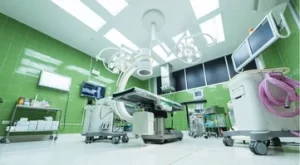 It is estimated that hospitals are missing savings of as much as 12-16% on medical equipment lifecycle costs. A portion of these costs can be tied back to poor asset utilization of mobile equipment (think any hospital equipment that moves, such as IV pumps, telemetry units, wheelchairs, etc.). In fact, hospitals on average have about 25% more devices than can be used at any one time. It is not uncommon to find equipment that has been sitting idle for days, weeks, or even months. This, combined with the fact that hospital staff often feel that they cannot find the equipment they need is a major challenge and inefficiency in healthcare.
It is estimated that hospitals are missing savings of as much as 12-16% on medical equipment lifecycle costs. A portion of these costs can be tied back to poor asset utilization of mobile equipment (think any hospital equipment that moves, such as IV pumps, telemetry units, wheelchairs, etc.). In fact, hospitals on average have about 25% more devices than can be used at any one time. It is not uncommon to find equipment that has been sitting idle for days, weeks, or even months. This, combined with the fact that hospital staff often feel that they cannot find the equipment they need is a major challenge and inefficiency in healthcare.
What is “Asset Utilization”?
Asset utilization is the percentage of the time a piece of hospital equipment is in use. If a hospital has a high utilization rate, the hospital is delivering care and generating revenue from that piece of equipment. However, if there is a low utilization rate, that means that the hospital has invested in excess capital that is sitting unused. This metric was listed as one of the top ten most important metrics in the hospital industry because of the direct link to a hospital’s revenue.
Why is There More Equipment in Hospitals?
Two main factors have contributed to the increase in hospital assets: technology advancements and more treatment options for patients. Compared to 1995, where there were only 8 devices at a patient’s bedside, this number jumped to 13 in 2010. These devices are creating a huge impact on healthcare and making sure they are being utilized is equally important!
What is the Cost of Ineffective Asset Management?
The increasing number of assets, coupled with ineffective utilization, has created a purchasing mess. Without the knowledge of where assets are and to what extent they are being used, purchase requests for equipment cannot be objectively justified. Department managers and clinical engineers are requesting equipment based on the feedback from their staff when their equipment is not readily available.
As a result, unnecessary purchases and rentals are made. When staff cannot find what they need, they must quickly rent equipment to keep up with patient demand. This leads to inflated equipment inventories with hundreds of additional assets that must be maintained every 6-12 months. This in turn inflates clinical engineering costs on top of the excess capital spent in renting the additional asset.
How Can Asset Tracking Help?
Implementing a technology solution like Asset Tracking is one important step to solving ineffective asset management. In the case of the SwipeSense Asset Tracking system, hospital equipment is assigned a Real-Time Location System (RTLS) tag that monitors location, usage and status of the device. With this asset tracking data hospitals can:
Improve utilization & allocation of assets:
- Instead of purchasing more equipment when clinicians cannot find what they need, equipment can simply be reallocated as necessary. Equipment can be moved from areas of low utilization to ones with higher utilization as usage fluctuates.
Decrease costs:
- Efficient asset utilization can reduce annual service costs and asset management costs. It can also help decrease the number of lost assets. For example, after one year of implementing real-time asset tracking technology, one facility reduced the number of lost telemetry transmitters from 36 to 6, resulting in cost savings of $15,000 annually.
Make informed purchasing decisions:
- With better data, hospitals are able to make more informed purchasing and rental decisions. Currently, hospitals often rely on supplier suggestions for purchasing quantities. Asset utilization data allows hospitals to assess their current equipment fleet sizes and usage and create their own fleet size requests, independent of the ones suggested by suppliers.
Improve patient outcomes:
- When hospital staff have immediate access to equipment, there is a better clinical outcome for the patient. The efficiency it creates can lead to improvements not only with patient length of stay, but also in decreasing re-admissions – two important areas for hospital performance metrics.
The nation’s healthcare spending is sky high. Luckily there is a solution. Through more effective asset management and utilization, hospitals will be able to more effectively spend and reallocate their money.
Interested in learning how SwipeSense Asset Tracking can help? Click here to view our Asset Tracking page or Schedule a Strategy Session today.
